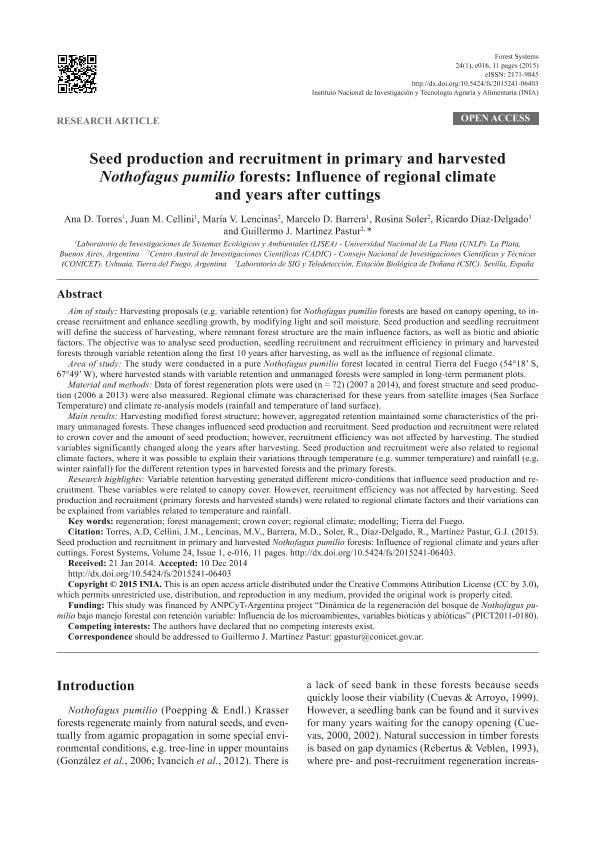Artículo
Seed production and recruitment in primary and harvested Nothofagus pumilio forests: Influence of regional climate and years after cuttings
Torres, Ana Delia; Cellini, Juan Manuel; Lencinas, María Vanessa ; Barrera, Marcelo Daniel; Soler Esteban, Rosina Matilde
; Barrera, Marcelo Daniel; Soler Esteban, Rosina Matilde ; Díaz Delgado, Ricardo; Martínez Pastur, Guillermo José
; Díaz Delgado, Ricardo; Martínez Pastur, Guillermo José
 ; Barrera, Marcelo Daniel; Soler Esteban, Rosina Matilde
; Barrera, Marcelo Daniel; Soler Esteban, Rosina Matilde ; Díaz Delgado, Ricardo; Martínez Pastur, Guillermo José
; Díaz Delgado, Ricardo; Martínez Pastur, Guillermo José
Fecha de publicación:
03/2015
Editorial:
Instituto Nacional de Investigación y Tecnología Agraria y Alimentaria
Revista:
Forest Systems
e-ISSN:
2171-9845
Idioma:
Inglés
Tipo de recurso:
Artículo publicado
Clasificación temática:
Resumen
Aim of study: Harvesting proposals (e.g. variable retention) for Nothofagus pumilio forests are based on canopy opening, to increase recruitment and enhance seedling growth, by modifying light and soil moisture. Seed production and seedling recruitment will define the success of harvesting, where remnant forest structure are the main influence factors, as well as biotic and abiotic factors. The objective was to analyse seed production, seedling recruitment and recruitment efficiency in primary and harvested forests through variable retention along the first 10 years after harvesting, as well as the influence of regional climate. Area of study: The study were conducted in a pure Nothofagus pumilio forest located in central Tierra del Fuego (54º18? S, 67º49? W), where harvested stands with variable retention and unmanaged forests were sampled in long-term permanent plots. Material and methods: Data of forest regeneration plots were used (n=72) (2007 a 2014), and forest structure and seed production (2006 a 2013) were also measured. Regional climate was characterised for these years from satellite images (Sea Surface Temperature) and climate re-analysis models (rainfall and temperature of land surface). Main results: Harvesting modified forest structure; however, aggregated retention maintained some characteristics of the primary unmanaged forests. These changes influenced seed production and recruitment. Seed production and recruitment were related to crown cover and the amount of seed production; however, recruitment efficiency was not affected by harvesting. The studied variables significantly changed along the years after harvesting. Seed production and recruitment were also related to regional climate factors, where it was possible to explain their variations through temperature (e.g. summer temperature) and rainfall (e.g. winter rainfall) for the different retention types in harvested forests and the primary forests. Research highlights: Variable retention harvesting generated different micro-conditions that influence seed production and recruitment. These variables were related to canopy cover. However, recruitment efficiency was not affected by harvesting. Seed production and recruitment (primary forests and harvested stands) were related to regional climate factors and their variations can be explained from variables related to temperature and rainfall.
Archivos asociados
Licencia
Identificadores
Colecciones
Articulos(CADIC)
Articulos de CENTRO AUSTRAL DE INVESTIGACIONES CIENTIFICAS
Articulos de CENTRO AUSTRAL DE INVESTIGACIONES CIENTIFICAS
Articulos(CCT - LA PLATA)
Articulos de CTRO.CIENTIFICO TECNOL.CONICET - LA PLATA
Articulos de CTRO.CIENTIFICO TECNOL.CONICET - LA PLATA
Citación
Torres, Ana Delia; Cellini, Juan Manuel; Lencinas, María Vanessa; Barrera, Marcelo Daniel; Soler Esteban, Rosina Matilde; et al.; Seed production and recruitment in primary and harvested Nothofagus pumilio forests: Influence of regional climate and years after cuttings; Instituto Nacional de Investigación y Tecnología Agraria y Alimentaria; Forest Systems; 24; 1; 3-2015; 1-11
Compartir



